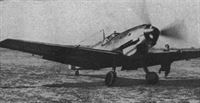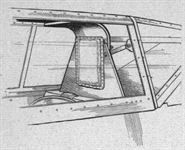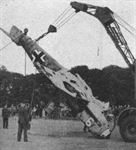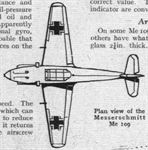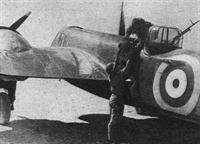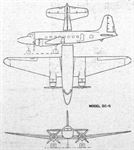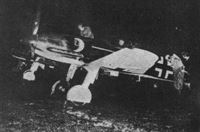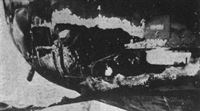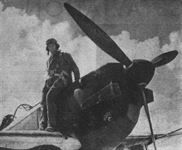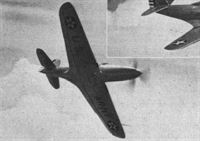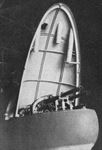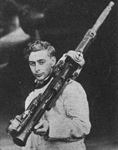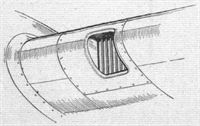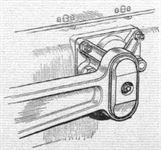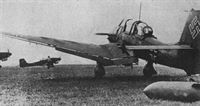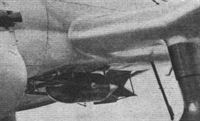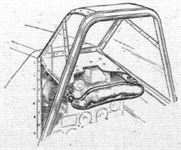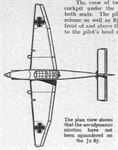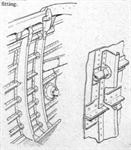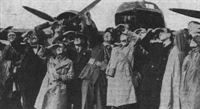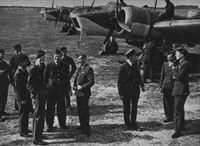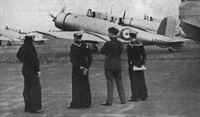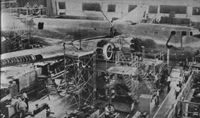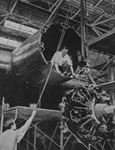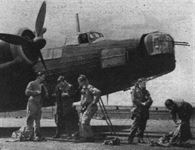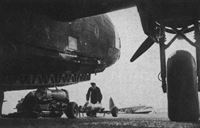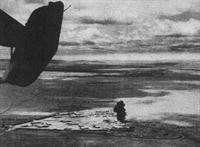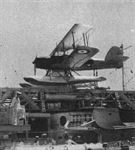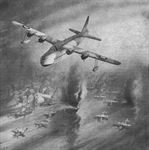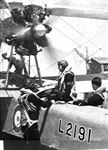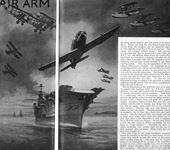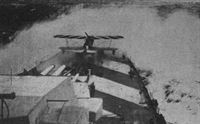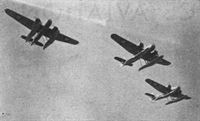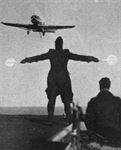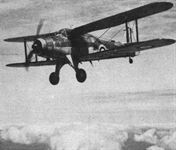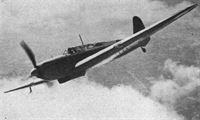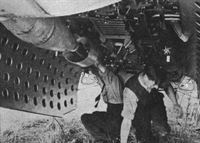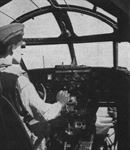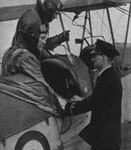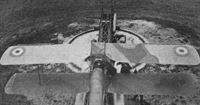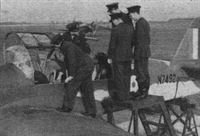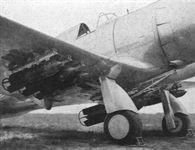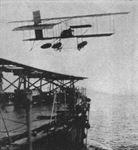Фотографии
-
In this photograph of the German single-seat fighter can be seen the three-bladed airscrew, the two wing guns, the sideways-retracting undercarriage and the mass-balanced ailerons. The flaps are down, as the machine has just landed and is taxying in.
Самолёты на фотографии: Messerschmitt Bf.109E - Германия - 1938
-
The fuselage joints which result from Messerschmitt construction are so smooth that they are barely discernible in this photograph.
Самолёты на фотографии: Messerschmitt Bf.109E - Германия - 1938
-
The Mercedes-Benz or Daimler-Benz DB 601 A is installed in the Me 109 on liberal-section engine mountings which are convenient for engine-changing. On the top of the engine can be seen the two machine guns which fire through the disc of the V.D.M. electrically operated feathering airscrew.
Самолёты на фотографии: Messerschmitt Bf.109E - Германия - 1938
-
The pilot of some Me 109s has armour plate both behind him and over his head. The head armour is attached to the hinged cockpit cover and so makes this rather weighty to lift up for entrance or exit.
Самолёты на фотографии: Messerschmitt Bf.109E - Германия - 1938
-
The Me 109 is not well provided with instruments. This drawing shows the cockpit and instrument board.
Самолёты на фотографии: Messerschmitt Bf.109E - Германия - 1938
-
The switch on the knob of the throttle lever which the pilot uses to alter airscrew pitch. While pitch is changing the the pitch indicator hands go round. The pitch required is set with reference to the rev counter.
Самолёты на фотографии: Messerschmitt Bf.109E - Германия - 1938
-
The control column and the gun triggers. Note the safety catch which can be turned over to prevent the button being pressed.
Самолёты на фотографии: Messerschmitt Bf.109E - Германия - 1938
-
Anson is as Anson Does: A Messerschmitt Me 109 which crash-landed in Windsor Great Park after attacking a pair of Ansons which the German pilot thought providence had served up to him ready cooked.
Самолёты на фотографии: Messerschmitt Bf.109E - Германия - 1938
-
Plan view of the Messerschmitt Me 109
Самолёты на фотографии: Messerschmitt Bf.109E - Германия - 1938
-
Messerschmitt fuselage construction has a longitudinal joint on top and bottom of the metal shell. Alternate plates have their edges flanged up into Z section "frames" and are joggled to give smooth joints. Riveting is flush and the stringers pass through the "frames" without attachment to them. Top and bottom stringers are of double width to allow the plates to butt on them and so avoid lap joints.
Самолёты на фотографии: Messerschmitt Bf.109E - Германия - 1938
-
The wing joint features pins at right angles for attaching the single spar to the fuselage. A third attachment ensures the transmission of torsional loads.
Самолёты на фотографии: Messerschmitt Bf.109E - Германия - 1938
-
The Oerlikon 20 mm. shell gun is in common use on German aircraft. Some Me 109s are provided with two in the wings. The explosive shell, giving the length of its cartridge case, is also shown.
Самолёты на фотографии: Messerschmitt Bf.109E - Германия - 1938
-
Mapping the Desert: A camera being installed in a Mark I Blenheim for a photographic reconnaissance. It is only worth while photographing the desert in the early morning or late evening when the small and shallow features cast their longest shadows.
Самолёты на фотографии: Bristol Blenheim - Великобритания - 1936
-
Самолёты на фотографии: Douglas DC-4 / C-54 / R5D Skymaster - США - 1942
-
INFORMATION: A German propaganda photograph showing how the bombs fall from a Dornier Do.17.
Самолёты на фотографии: Dornier Do.17Z / Do.215 - Германия - 1939
-
MORE INFORMATION: A British photograph showing how the Dorniers themselves follow the wake of their bombs right down to the ground.
Самолёты на фотографии: Dornier Do.17Z / Do.215 - Германия - 1939
-
NIGHT FLYING NIGHTMARE: The Me 109 is known to be unpleasant to fly at speed during the daytime. At night more attention must be paid to the flying than the fighting.
Самолёты на фотографии: Heinkel He-100 - Германия - 1938
-
The burnt-out rear lower gun turret and bomb bay of the Handley Page Hampden on which Sgt. Hannah was flying when he earned the V.C.
Самолёты на фотографии: Handley Page Hampden / H.P.52 - Великобритания - 1936
-
BOLD SILHOUETTE: Hurricane eight-gun fighters returning home after their successful interception of an enemy raid.
Самолёты на фотографии: Hawker Hurricane - Великобритания - 1935
-
THE EAGLE SQUADRON. A group of pupils with (in centre, right) Group Capt. Charles Sweeney, R.A.F.V.R., the Honorary Commanding Officer of the Squadron and (centre, left) Squadron Leader William Erwin Gibson Taylor, the Commanding Officer. Squadron Leader Taylor was granted a Commission in the Fleet Air Arm of the Royal Navy on the outbreak of war.
Самолёты на фотографии: Hawker Hurricane - Великобритания - 1935
-
ROYAL INSPECTION: A Hurricane comes in to land while the King inspects officers of a Royal Canadian Air Force Squadron. The fighter station which His Majesty visited includes a Polish squadron in addition to those of the R.A.F. and R.C.A.F.
Самолёты на фотографии: Hawker Hurricane - Великобритания - 1935
-
Czech armourers rearming the Browning guns of the Hurricanes with which they are equipped.
Самолёты на фотографии: Hawker Hurricane - Великобритания - 1935
-
Самолёты на фотографии: Hawker Hurricane - Великобритания - 1935
-
Регистрационный номер: P2579 HURRICANES IN ECHELON. During the first year of war more than 1,500 enemy aircraft were brought down by Hurricanes.
Самолёты на фотографии: Hawker Hurricane - Великобритания - 1935
-
OPERATIONAL TRAINING UNIT: Sqn. Ldr. P. Townsend, D.F.C. - in centre with stick - still remains on duty despite a foot wounded by a cannon shell. Among his pilots are two Frenchmen, two Poles, a New Zealander and one from Nigeria.
Самолёты на фотографии: Hawker Hurricane - Великобритания - 1935
-
Регистрационный номер: L1648 A WINNER, HANDS DOWN - or up, according to which way you look at it. Flt. Lt. Philip Lucas shows that our new monoplane fighters are by no means intractable. In this unique Flight photograph he has put the Hurricane on its back and removed both hands from the stick; one hand is hiding the other, but both were definitely raised - or lowered.
Test pilot Philip Lucas enjoying himself in Hurricane Mk I L1648 in September 1938.Самолёты на фотографии: Hawker Hurricane - Великобритания - 1935
-
TIGHT FORMATION: The Hurricane is exceptionally manoeuvrable and accurate in response to the controls. This picture was obtained above the clouds over France earlier this year.
Самолёты на фотографии: Hawker Hurricane - Великобритания - 1935
-
PRE-WAR VINTAGE: No. 111 (Fighter) Squadron were the first squadron to be re-equipped with Hawker Hurricanes and are seen here in squadron "vic."
Самолёты на фотографии: Hawker Hurricane - Великобритания - 1935
-
RECONDITIONED: Sturdiness and ability to take punishment are characteristics of the Hurricane, and its form of construction enables repairs to be carried out quickly. This type has a Rotol airscrew with wooden blades.
Самолёты на фотографии: Hawker Hurricane - Великобритания - 1935
-
OFFICE OF WORKS: In this picture of the pilot's cockpit can be seen the blind-flying panel with compass beneath; the gun trigger on the joy stick spade grip; the seat raising and lowering lever, and the emergency hand pump for operating flaps and undercarriage
Самолёты на фотографии: Hawker Hurricane - Великобритания - 1935
-
PUNISHING POWER: The ammunition boxes, feeds and four Browning guns which constitute the armament of one wing of the Hurricane.
Самолёты на фотографии: Hawker Hurricane - Великобритания - 1935
-
ALL SET: The pilot dons his parachute while the engine is started by the battery trolley on the right-hand side. Flaps are already in the take-off position so that no time is lost. The aerial arrangement is clearly shown with the rear post directly over the rudder hinge line. On the elevator are seen the fixed and movable trimming tabs.
A 56 Sqn Hurricane taking part in the annual Air Exercises in August 1939. As the pilot dons his brolly the trolley-ack is at the ready and the Hurricane’s flaps are lowered.Самолёты на фотографии: Hawker Hurricane - Великобритания - 1935
-
Югославия. Заказ на 12 истребителей Hurricane Mk I разместили в 1938 году, первые две машины поставили в декабре. Вскоре последовал второй заказ еще на 12 Mk I, их поставка началась в феврале 1940 года. Примерно в это же время в Югославии началась лицензионная сборка Hurricane на белградском заводе "PSFAZ Rogozarski" и на предприятии "Fabrika Aeroplana I Hidroplana Zenun". К началу немецкого вторжения на Балканы в апреле 1941 года в югославских ВВС было 38 Hurricane (фото), включая 15 собранных в Югославии машин. В течение недели большинство из них было сбито или уничтожено на земле.
FOR YUGOSLAVIA: A Hawker test pilot putting a Yugoslav Hurricane through its paces.Самолёты на фотографии: Hawker Hurricane - Великобритания - 1935
-
ON THE WAY: Hurricanes in various stages of erection.
Самолёты на фотографии: Hawker Hurricane - Великобритания - 1935
-
ON THEIR WAY: Three Hurricanes taking off in formation from an R.A.F. aerodrome. The rate of climb at sea level is 2,400 ft./min.
Самолёты на фотографии: Hawker Hurricane - Великобритания - 1935
-
FIVE YEARS' PROGRESS: The evolution of the Hurricane since its first flight in Nov. 1935 to the present day. After the first flight the engine cowling was bent by the battering of the slipstream, and the first real dive, and zoom across the aerodrome sucked the panels out of the cockpit cover. In the production model the tail wheel is no longer retractable, the cockpit cover redesigned and streamline exhausts fitted.
Самолёты на фотографии: Hawker Hurricane - Великобритания - 1935
-
FIVE YEARS' PROGRESS: The evolution of the Hurricane since its first flight in Nov. 1935 to the present day. At the stage when the photograph was taken the wooden airscrew was still in use, but ejector exhausts had been fitted. Metal wings were beginning to come through the shops.
Самолёты на фотографии: Hawker Hurricane - Великобритания - 1935
-
HURRICANE PILOT: Dressed for modern high flying the pilot has a fur lined Irvin suit and seat type parachute. The face mask incorporates oxygen breathing apparatus and microphone. Closing the hand-hold on the right of the picture causes the step to retract.
Самолёты на фотографии: Hawker Hurricane - Великобритания - 1935
-
FIVE YEARS' PROGRESS: The evolution of the Hurricane since its first flight in Nov. 1935 to the present day. The picture shows it in its present day style with bullet proof windscreen, three bladed constant speed airscrew and anti-spin fin surface under the tail.
Самолёты на фотографии: Hawker Hurricane - Великобритания - 1935
-
The two men who are primarily responsible for the remarkable success of the Hurricane. Mr. Sydney Camm (right), as Hawker's chief designer, bore the responsibility for the technical features of the machine, while Flt. Lt. P. W. S. Bulman ("George") did the testing of the prototype, thus contributing his share in producing a machine which pilots love to fly.
Самолёты на фотографии: Hawker Hurricane - Великобритания - 1935
-
UNCONVENTIONAL DETERMINATION: The starboard wing of a Hurricane after the pilot had used it to bring down an enemy machine by breaking off the tail with repeated blows from his wing tip.
Самолёты на фотографии: Hawker Hurricane - Великобритания - 1935
-
The Hawker Hurricane
Самолёты на фотографии: Hawker Hurricane - Великобритания - 1935
-
The outer wing construction of the original Hurricane, and should be compared with the metal-covered wing.
Самолёты на фотографии: Hawker Hurricane - Великобритания - 1935
-
How the laterally-retracting undercarriage works is shown here.
Самолёты на фотографии: Hawker Hurricane - Великобритания - 1935
-
Самолёты на фотографии: Hawker Hurricane - Великобритания - 1935
-
A Ju 88 showing the dive indicator line on the cockpit screen.
Самолёты на фотографии: Junkers Ju.88 - Германия - 1936
-
The rudder pedal and brake cylinder are mounted as an assembly on an adjustable slide which allows different lengths of leg to be accommodated quickly. Parallel action is assured by the pedal pivoting about the two lower bolts. All parts are machined castings.
Самолёты на фотографии: Junkers Ju.88 - Германия - 1936
-
With petrol injection engines the throttle consists of a control on the amount of petrol pumped into the cylinder at each stroke. As this is a minute quantity, very fine adjustment on the throttle lever is needed and the drawing shows how this is provided by three means, two of them being relatively coarse.
Самолёты на фотографии: Junkers Ju.88 - Германия - 1936
-
Aileron control is by bevel gear and shaft drive down the interior of the control column through a universal joint. Machined castings are freely used.
Pedal for applying the brake on the control surfaces is alongside the control column and is marked "Ruder Bremse."Самолёты на фотографии: Junkers Ju.88 - Германия - 1936
-
ALMOST INTACT: A Junkers Ju 88 bomber which was brought down near the coast. Several of its salient features are easily discernible. The typical German "beetle-eye" bomb-aimer compartment; the circular radiators and the diving brakes under the wing. In the triangle under the pilot's windscreen the figures 87 denote the octane value of the fuel employed.
Самолёты на фотографии: Junkers Ju.88 - Германия - 1936
-
A leather bellows joins the warm air intake to the supercharger so as to provide flexibility and allow some movement.
Самолёты на фотографии: Junkers Ju.88 - Германия - 1936
-
The cooling fluid and oil radiators are arranged in circular fashion in front of the inverted vee-twelve engine. The airscrew is a V.D.M. with de-icing equipment.
Самолёты на фотографии: Junkers Ju.88 - Германия - 1936
-
The rear two of the four ball joints attaching the fin to the fuselage. The fairing has been removed. The lower rudder hinge may be seen.
Самолёты на фотографии: Junkers Ju.88 - Германия - 1936
-
The typical Junkers ball joints are used to connect the wing spars at the main joint. The ball is held into the socket by the screwed ring which can be turned by the holes round its circumference.
Самолёты на фотографии: Junkers Ju.88 - Германия - 1936
-
The inflatable rubber boat is provided with four oars for propulsion and another for steering, each of which, by two simple joints, breaks up into three sections for stowage. An emergency pump is available if the compressed air bottle becomes exhausted.
Самолёты на фотографии: Junkers Ju.88 - Германия - 1936
-
Diagram illustrating the diving angles of the Ju 88.
Самолёты на фотографии: Junkers Ju.88 - Германия - 1936
-
MIDDLE EAST MISCELLANY: A French pilot, serving with the R.A.F. in the Western Desert, who has his own Morane 406. The 20 mm. Hispano shell gun can be seen projecting through the airscrew hub.
Самолёты на фотографии: Morane-Saulnier MS.405/406/410C1 - Франция - 1935
-
The United States Bell P-39 Airacobra fighter. Rated as an interceptor it is armed with a 37 mm shell gun firing through the airscrew hub of the Allison engine. Two 0.5 in. synchronised machine guns are mounted in the fuselage, firing through the airscrew disc, and provision is made in the wings for four more machine guns.
Самолёты на фотографии: Bell P-39 Airacobra - США - 1939
-
Самолёты на фотографии: Bell P-39 Airacobra - США - 1939
-
GERMAN DESIGN. Many of the features of the Me 110 are visible in this photograph. The typical German design of engine mounting will be noticed and the upturned exhaust pipes on the outboard side of the nacelle. Underneath is the oil radiator and immediately above it is a small device which de-aerates the petrol before it goes to the injection pumps. The simplicity of undercarriage design is noteworthy and it will be seen how the radiator has been placed under the wing. In the background the efficient lines of the tail unit are apparent.
Самолёты на фотографии: Messerschmitt Bf.110 - Германия - 1936
-
The four MG 17 machine guns in the fuselage nose of the Me 110 are readily accessible for maintenance by lifting the cover.
Самолёты на фотографии: Messerschmitt Bf.110 - Германия - 1936
-
One of the two Oerlikon 20 mm. shell guns which are mounted in the lower half of the fuselage.
Самолёты на фотографии: Messerschmitt Bf.110 - Германия - 1936
-
Plan view of the Me 110 shows orthodox modern proportions.
Самолёты на фотографии: Messerschmitt Bf.110 - Германия - 1936
-
The ingenious catch which holds the cover in position over the guns in the fuselage nose.
Самолёты на фотографии: Messerschmitt Bf.110 - Германия - 1936
-
The air intake leading to the supercharger of the port engine is in the leading edge of the wing and has guide vanes to reduce frictional losses.
Самолёты на фотографии: Messerschmitt Bf.110 - Германия - 1936
-
Inspection doors on the Me 110 spring out when pressed with the finger tip.
Самолёты на фотографии: Messerschmitt Bf.110 - Германия - 1936
-
The forward attachment point of the engine is a rubber mounting which allows some vertical movement.
Самолёты на фотографии: Messerschmitt Bf.110 - Германия - 1936
-
This three-quarter rear view of the Junkers Ju 87 shows the Junkers "double wing" ailerons and flaps and the heavily cranked wing. For dive-bombing it is very desirable to carry the bombs externally and this fact and the fixed undercarriage combine to keep the speed low, although the engine is the powerful Junkers Jumo 211D, rated at 1,200 h.p. for take-off.
Самолёты на фотографии: Junkers Ju.87B - Германия - 1938
-
In this picture of the Ju 87 will been seen the mounting details of the engine, and the diving brakes under the wing will also be noticed. The trousered undercarriage of the earlier type has been replaced by spats.
Самолёты на фотографии: Junkers Ju.87B - Германия - 1938
-
The most powerful blow of the Ju 87 is delivered with this 1,100 lb. bomb which is carried under the fuselage and is swung clear of the airscrew by two arms when released.
Самолёты на фотографии: Junkers Ju.87B - Германия - 1938
-
This head bumper bar helps to protect the pilot during pull-outs and crashes.
Самолёты на фотографии: Junkers Ju.87B - Германия - 1938
-
The plan view shows that the aerodynamic niceties have not been squandered on the Ju 87.
Самолёты на фотографии: Junkers Ju.87B - Германия - 1938
-
The single leg of the fixed undercarriage is attached to the front wing spar by this welded steel fitting.
Самолёты на фотографии: Junkers Ju.87B - Германия - 1938
-
The longitudinal joint of two angles and the close stringer spacing at the bottom can be seen in this fuselage drawing.
Самолёты на фотографии: Junkers Ju.87B - Германия - 1938
-
FLEDGLINGS: The first contingent of Jim Crows to take the 14-day R.A.F. course of instruction in roof watching. In London the roof watchers have quite defeated the nuisance raider who floats around in thick cloud pretending to be a lot of him.
Самолёты на фотографии: Bristol Blenheim IV/Bolingbroke - Великобритания - 1937
-
FIGHTER ESCORTS: The Fighter squadron of Coastal Command fly long-nosed Blenheims which have had fitted a battery of four Browning guns under the fuselage. With a speed of 295 m.p.h. and a range of some 2,000 miles, these machines are capable of escorting bombers or reconnaissance machines deep into enemy territory.
Самолёты на фотографии: Bristol Blenheim IV/Bolingbroke - Великобритания - 1937
-
The leader of the three Fighter Blenheims which attacked forty Me 110s and shot down two of them.
Самолёты на фотографии: Bristol Blenheim IV/Bolingbroke - Великобритания - 1937
-
FIRE: This thumb pressed this gun trigger when three Fighter Blenheims of the Coastal Command saw and attacked a formation of forty Me 110s, shot down two of them and got away home safely.
Самолёты на фотографии: Bristol Blenheim IV/Bolingbroke - Великобритания - 1937
-
ORIGINAL THEME WITH VARIATION. Two Skuas and a Roc of the Fleet Air Arm. The latter has a Boulton-Paul turret.
Самолёты на фотографии: Blackburn Roc / B-25 - Великобритания - 1938Blackburn Skua / B-24 - Великобритания - 1937
-
Регистрационный номер: L2933 ON A LAND SHIP: Blackburn Skuas which, with their fighting contemporaries the Rocs, are standard dive-bombers of the Navy, are seen here taking off from one of the Fleet Air Arm's aerodromes. It is interesting to note that all naval establishments, whether ashore or afloat, are treated as if they were ships, thus in the training establishment we find the names H.M.S. Daedalus H.M.S. Raven, and H.M.S. Kestrel
Самолёты на фотографии: Blackburn Roc / B-25 - Великобритания - 1938
-
The Blackburn Roc differs from the Skua mainly in that it has a Boulton-Paul four-gun turret in place of the four fixed and one movable guns of the Skua.
Designed to fulfil a similar role to the Defiant, but constricted by stringent naval requirements and its less powerful radial engine, the Blackburn Roc was fitted with the same Boulton Paul Type A four-gun turret as its RAF counterpart. By the time it flew in 1938, British interest in 37mm armament for air-to-air fighting was on the wane.Самолёты на фотографии: Blackburn Roc / B-25 - Великобритания - 1938
-
DEMOCRACY'S SWORD AND ARMOUR: The wing and fuselage of the Douglas B-19 bomber join company in the factory at Santa Monica where this great aeroplane is under construction for the U.S. Army Air Corps. The hoses going in through the cockpit windows are probably for sucking out or delivering ventilating air.
Самолёты на фотографии: Douglas XB-19 - США - 1941
-
The wing was built in the vertical position on a specially constructed staging. Though the engine nacelles are of very large proportions, they are dwarfed by the wing.
Самолёты на фотографии: Douglas XB-19 - США - 1941
-
Typically "Douglas" in shape, the tail unit is itself a tremendous structure. The elevator appears to be fabric-covered.
Самолёты на фотографии: Douglas XB-19 - США - 1941
-
Installing one of the 18-cylinder two-row Wright Duplex Cyclones, which have a take-off rating approximating 2,000 h.p. Attachment is by "dynamic mounting" to the cylinder heads at the nine points seen on the nacelle.
Самолёты на фотографии: Douglas XB-19 - США - 1941
-
GETTING THINGS BUTTONED UP: An air crew putting on their Irvin Harnisuits, which incorporate both parachute harness and flotation jacket. The machine is a Wellington Ia, which has a twin gun turret in the nose.
Самолёты на фотографии: Vickers Wellington / Type 271 - Великобритания - 1936
-
INCIPIENT RETRIBUTION: A Vickers Wellington in the process of being "bombed up" prior to a night raid on Germany.
Самолёты на фотографии: Vickers Wellington / Type 271 - Великобритания - 1936
-
Thereby hangs a tale: The result of a raid by the South African Air Force on an Italian aerodrome in Abyssinia. It is apparent from the tail which appears in the top left corner that the machines used by the S.A.A.F. were Junkers Ju 86s bought before the outbreak of hostilities.
Самолёты на фотографии: Junkers Ju.86 - Германия - 1934
-
FOX INTERCOMMUNICATION: One of the C 30 Autogiros built by Avros which are now used for intercommunication work between units. The official service designation is Rota.
Самолёты на фотографии: Cierva/Avro C.30A / Rota - Великобритания - 1932
-
Hot Work for Coolies: The remains of a Japanese fighter being removed to the local scrap heap by Chinese coolies. In its better days it appears to have been a Mitsubishi "Karigane" two-seater general purpose monoplane.
Самолёты на фотографии: Mitsubishi Ki.15/C5M/Karigane - Япония - 1936
-
A formation of Blackburn Sharks. They belong to a class of aircraft known as "T.S.R.," the letters indicating that the duties include torpedo-dropping, spotting, and reconnaissance.
Самолёты на фотографии: Blackburn Shark / B-6 - Великобритания - 1933
-
A Fairey Seafox on the catapult of H.M.S. Neptune.
Самолёты на фотографии: Fairey Seafox - Великобритания - 1936
-
Out of its element: A Short Sunderland of Coastal Command pulled up the slipway for overhaul. This is one of the boats manned by the Royal Australian Air Force.
Самолёты на фотографии: Short Sunderland / S.25 - Великобритания - 1937
-
OUT OF THE SUN. A Short Sunderland attacks Dornier Do.18s at moorings. German flying boats have proved no match for this formidable R.A.F. machine, which outflies and outfights them whenever contact is made.
Самолёты на фотографии: Dornier Do.18 - Германия - 1935Short Sunderland / S.25 - Великобритания - 1937
-
Регистрационный номер: L2191 TRAINING THE LOWER DECK: There are seen ratings entering the rear cockpit of a Vickers Walrus.
Самолёты на фотографии: Supermarine Walrus/Seagull V - Великобритания - 1933
-
BELLBOTTOMS AND BRACES: A naval rating assists a Petty Officer pilot into his parachute harness. The machine in the background is a Vickers Walrus and the folder marked "serviceable" contains details of each flight made and is signed by the pilot before each flight.
Самолёты на фотографии: Supermarine Walrus/Seagull V - Великобритания - 1933
-
SHIPPING IT GREEN: A Meridionali 43 reconnaissance aircraft on the catapult of an Italian cruiser. The position of the catapult in the bows of the ship seems to give the aircraft a hard time compared with the sheltered position of the double catapults abaft the beam on our cruisers.
Самолёты на фотографии: IMAM(Meridionali) Ro.43/Ro.44 - Италия - 1936
-
LENDING A HAND: Fokker T8-W float-planes of the Royal Dutch Naval Air Service on patrol. The R.A.F. tricoloured roundels have been painted over the Dutch orange triangle to obviate confusion in identification. The T8-W is a torpedo reconnaissance machine carrying a crew of three. A fixed 7.9 m.m. machine gun is mounted in the port side and operated by the pilot. A free gun of the same size on a retractable mounting is provided for the rear gunner. The bombs and torpedo are internally stowed.
Самолёты на фотографии: Fokker T.VIIIW - Нидерланды - 1939
-
DECK LANDING: With hook down to catch the arrester wires and flaps down to steepen the glide, a Blackburn Skua comes in to alight. The officer with the two discs gives an indication as to whether the approach is correct.
Самолёты на фотографии: Blackburn Skua / B-24 - Великобритания - 1937
-
Регистрационный номер: K8440 GOING DOWN: A Fairey Swordfish disappearing from sight down the aft lift well. All carrier-borne aircraft, with the exception of single-seaters, must have folding wings to enable them to be raised and lowered on the cruciform lifts of which there is one at each end of the flying deck.
Самолёты на фотографии: Fairey Swordfish - Великобритания - 1934
-
Регистрационный номер: L9781 SUNK BY GOEBBELS AND GAYDA: The 22,000-ton aircraft carrier H.M.S. Ark Royal. Completed in 1938 this is one of our latest carriers to be put into commission. It has a length of 800 ft. and an aircraft capacity of seventy machines. In addition to a considerable quantity of small calibre ordnance, it has a main armament of sixteen 4.5 guns. The machine circling in the foreground is a Fairey Swordfish, a type which has done such excellent work both in the North Sea and the Mediterranean.
Самолёты на фотографии: Fairey Swordfish - Великобритания - 1934
-
A STERN VIEW: This photograph gives a good idea of the vast expanse of H.M.S. Ark Royal's flying deck. Anti-aircraft guns can be seen along the sides where also are the palisades where personnel are stationed during flying operations.
Самолёты на фотографии: Fairey Swordfish - Великобритания - 1934
-
ANOTHER FLEET AIR ARM TYPE. The Fairey Albacore is enabled by its large wing area to carry a very heavy military load.
The Albacore (Taurus) can be used for dive-bombing, torpedo-dropping, fleet spotting and reconnaissance.Самолёты на фотографии: Fairey Albacore - Великобритания - 1938
-
The Fairey P.4/34 in its original form. The type has been ordered recently by the Admiralty in a modified form known as the Fulmar.
Самолёты на фотографии: Fairey Fulmar / P.4/34 - Великобритания - 1937
-
THE BOMB BAY: Bombing up a Lockheed Hudson prior to a reconnaissance. A supply of anti-submarine bombs is always kept in the locker.
Самолёты на фотографии: Lockheed Hudson A-28 / A-29 - США - 1938
-
FEEDING THE GUNS: Threading ammunition belts of a thousand rounds each to the Brownings in the Hudson's rear turret. The bulge on the door contains the rubber dinghy, while on the left are seen racks for parachutes and Verey light cartridges. The well at the bottom of the fuselage is a retractable gun platform for tail protection.
Loading ammunition for the Hudson's dorsal turret, which was of Boulton Paul type, with twin 0-303in machine guns. The camera is looking aft.Самолёты на фотографии: Lockheed Hudson A-28 / A-29 - США - 1938
-
THE FORE END: A pilot at the controls of a Hudson. Note the row of bomb selector switches on the right of the lever marked "brake" and the navigator-bomb aimer's compartment in the nose.
Самолёты на фотографии: Lockheed Hudson A-28 / A-29 - США - 1938
-
The navigator-bomb aimer at the prone bomb sight over the optical flat panel. Note the chair pushed forward under the chart table and the compass on the right. Concentrated "Flak" and searchlights seen through this panel must, to say the least, give one a thrill.
Самолёты на фотографии: Lockheed Hudson A-28 / A-29 - США - 1938
-
MORE EMPIRE TRAINING: Pilot pupils at the Elementary Flying Training School at Narromine, Australia. They will go to Canada for advanced training.
Самолёты на фотографии: De Havilland Tiger Moth / D.H.82 - Великобритания - 1931
-
Ab initio flying training is, of course, carried out on land aerodromes, and here is seen pupils on a Tiger Moth which is one of the standard types used for this purpose. The rear cockpit, it will be noticed, has a blind-flying hood attached. Accurate instrument flying is a very essential part of naval air training.
Самолёты на фотографии: De Havilland Tiger Moth / D.H.82 - Великобритания - 1931
-
A De Havilland Queen Bee about to be catapulted into the air.
Самолёты на фотографии: De Havilland Queen Bee / D.H.82B - Великобритания - 1935
-
Регистрационный номер: N7492 Pupils of the Eagle Squadron being introduced by their R.A.F. instructors to the Miles Master Trainer on which they will receive their advanced training.
Самолёты на фотографии: Miles Kestrel M.9 / Master I M.9A - Великобритания - 1937
-
The Republic "Guardsman" two-seater fighter and dive bomber.
Самолёты на фотографии: Seversky SEV-2PA / AT-12 - США - 1937
-
Offensive armament comprises one 750 lb. bomb and six 100-pounders.
Самолёты на фотографии: Seversky SEV-2PA / AT-12 - США - 1937
-
LINK WITH THE PAST: The squadron visited is the successor of a R.N.A.S. squadron which was equipped with the Nieuport Scout.
OF FRENCH ORIGIN: THE NIEUPORT 1 1/2 PLANE WAS CHARACTERISED BY A VERY SMALL LOWER WING.Самолёты на фотографии: Nieuport Nieuport-12 - Франция - 1915
-
AMPHIBIOUS BUT ONLY JUST: In 1912 Commander Samson, one of the original four R.N. lieutenants to learn to fly, taking off on a Short S.38 from a platform on H.M.S. Hibernia while the vessel was travelling at 15 knots. The S.38 had wheels for the take-off and air-bag floats for alighting on the water afterwards.
Самолёты на фотографии: Short S.33 / S.38 seaplane - Великобритания - 1912
-
Самолёты на фотографии: Focke-Wulf FW.187 Falke - Германия - 1937
-
A FAMOUS SHIP: H.M.S. Exeter with a Fairey IIIF in the stowed position on the port catapult. H.M.S. Exeter, it will be remembered, played the leading part in the River Plate battle when the German pocket battleship Graf Spee took to her heels and, finally, scuttled herself.
Самолёты на фотографии: Fairey Fairey IIIF - Великобритания - 1926
Статьи
- Flight
- Flight Advertisements
